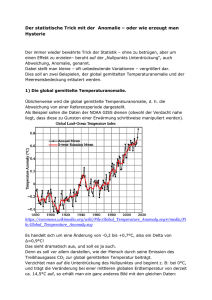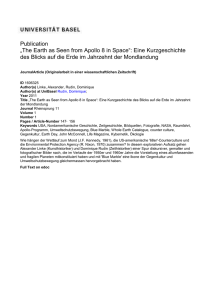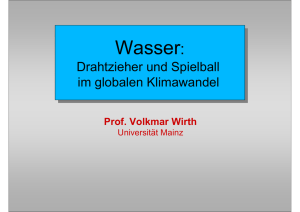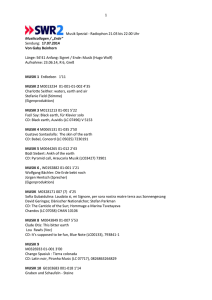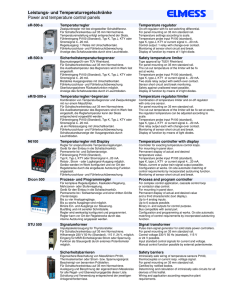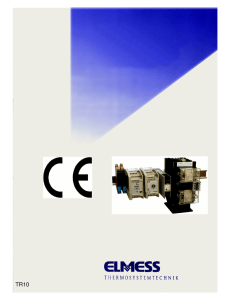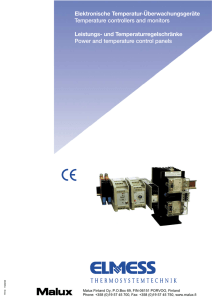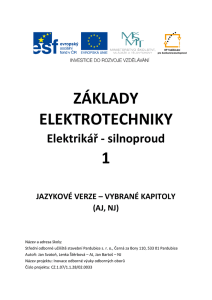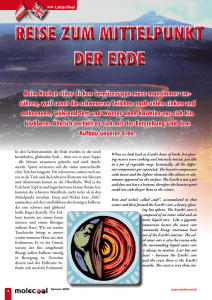Serie 1
Werbung
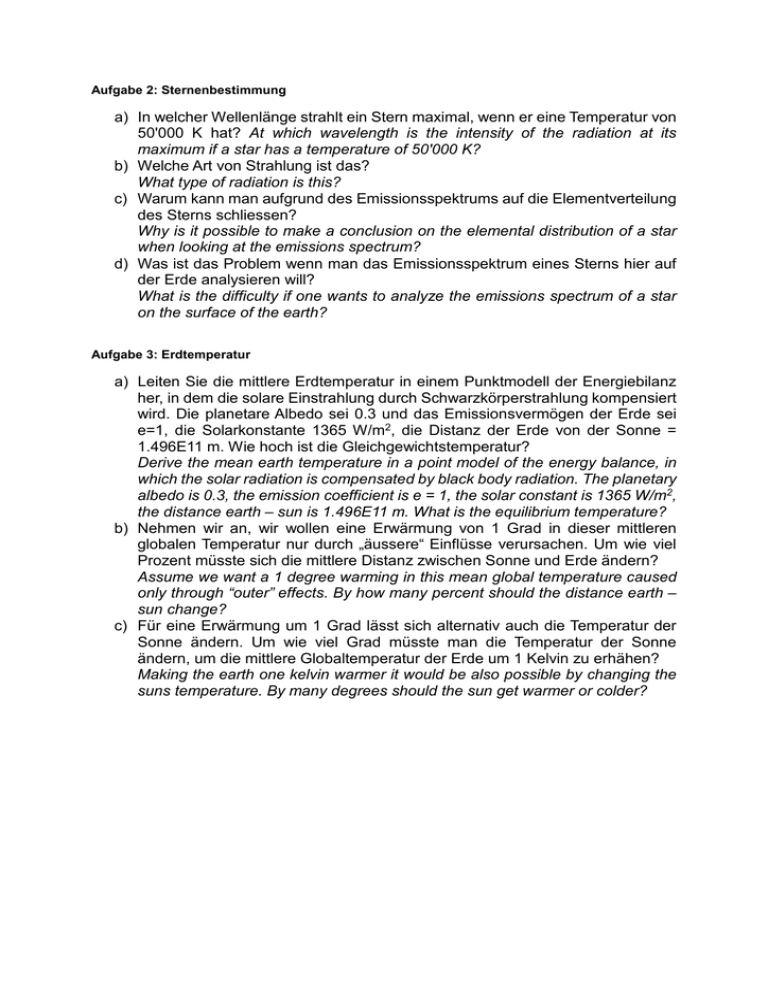
Aufgabe 2: Sternenbestimmung a) In welcher Wellenlänge strahlt ein Stern maximal, wenn er eine Temperatur von 50'000 K hat? At which wavelength is the intensity of the radiation at its maximum if a star has a temperature of 50'000 K? b) Welche Art von Strahlung ist das? What type of radiation is this? c) Warum kann man aufgrund des Emissionsspektrums auf die Elementverteilung des Sterns schliessen? Why is it possible to make a conclusion on the elemental distribution of a star when looking at the emissions spectrum? d) Was ist das Problem wenn man das Emissionsspektrum eines Sterns hier auf der Erde analysieren will? What is the difficulty if one wants to analyze the emissions spectrum of a star on the surface of the earth? Aufgabe 3: Erdtemperatur a) Leiten Sie die mittlere Erdtemperatur in einem Punktmodell der Energiebilanz her, in dem die solare Einstrahlung durch Schwarzkörperstrahlung kompensiert wird. Die planetare Albedo sei 0.3 und das Emissionsvermögen der Erde sei e=1, die Solarkonstante 1365 W/m2, die Distanz der Erde von der Sonne = 1.496E11 m. Wie hoch ist die Gleichgewichtstemperatur? Derive the mean earth temperature in a point model of the energy balance, in which the solar radiation is compensated by black body radiation. The planetary albedo is 0.3, the emission coefficient is e = 1, the solar constant is 1365 W/m2, the distance earth – sun is 1.496E11 m. What is the equilibrium temperature? b) Nehmen wir an, wir wollen eine Erwärmung von 1 Grad in dieser mittleren globalen Temperatur nur durch „äussere“ Einflüsse verursachen. Um wie viel Prozent müsste sich die mittlere Distanz zwischen Sonne und Erde ändern? Assume we want a 1 degree warming in this mean global temperature caused only through “outer” effects. By how many percent should the distance earth – sun change? c) Für eine Erwärmung um 1 Grad lässt sich alternativ auch die Temperatur der Sonne ändern. Um wie viel Grad müsste man die Temperatur der Sonne ändern, um die mittlere Globaltemperatur der Erde um 1 Kelvin zu erhähen? Making the earth one kelvin warmer it would be also possible by changing the suns temperature. By many degrees should the sun get warmer or colder? Aufgabe 4: Schichtung Figur 2: Die Figur zeigt zwei idealisierte Temperaturprofile. The above figure shows two idealized temperature profiles. a) Die gestrichelte Linie in Figur 2 beschreibt eine neutrale Schichtung angezeigt durch den trockenadiabatischen Temperaturgradient Γd = g/cp. Entlang dieser Linie ändert sich die potentielle Temperatur theta (θ) nicht. Die durchgezogene Linie beschreibt den tatsächlichen Verlauf der Temperatur mit der Höhe. Welches der Profile zeigt eine stabile Schichtung? Wie verhält sich die potentielle Temperatur theta (θ) mit der Höhe für die beiden Fälle? Begründen Sie ihre Antwort. The dashed line in figure 2 describes a neutral stability of atmosphere indicated by the dry adiabatic lapse rate Γd = -g/cp. Potential Temperature θ is constant along this line. The black line describes the Temperature T as a function of height (z). Which of the two profiles shows a stable temperature profile? How does θ change with height in these two cases. Please explain your answers. b) Welches der Profile (stabile oder instabile Schichtung) ist an einem sonnigen Sommertag am Nachmittag in der Grenzschicht der Atmosphaere zu erwarten? Welche Schichtung ist häufig in den hohen Breiten vorzufinden? Begründen Sie Ihre Antworten kurz. Which of the two profiles (stable or unstable temperature profile) would you expect on a clear summer day in the boundary layer of the atmosphere? Which stability is often seen in high latitudes? Explain briefly why. c) Beschreiben Sie die Geschichte eines aufsteigenden Luftpakets bei instabiler Schichtung. Wie verhält sich die Temperatur des Pakets und warum? Describe what happens to an ascending air parcel during the ascent when the stratification of the atmosphere is unstable. What does it mean for its temperature? Please explain! d) Nehmen Sie an, das Paket erreicht während des Aufstiegs das Kondensationsniveau (100% relative Luftfeuchtigkeit). Was passiert mit dem Luftpaket und welchen Effekt hat dies auf die Temperatur? Assume the parcel reaches its condensation level (100% relative humidity)? What will happen to the parcel and how will the temperature change? Aufgabe Temperatur der Erde a) Die solare Einstrahlung am Oberrand der Atmosphäre betrage S0 = 1600 W/m2. Welche Oberflächentemperatur hätte die Erde ohne Atmosphäre bei einer Albedo von 0.3? b) Unter Betrachtung des Strahlungsgleichgewichts mit Atmosphäre erhält der Erdboden zusätzlich langwellige Strahlung von der Atmosphäre. Stellen Sie das Strahlungsgleichgewicht für die Oberfläche der Erde auf und berechnen sie die Oberflächentemperatur. Die Atmosphäre ist für solare Strahlung transparent und besitzt ein Emissionsvermögen von epsilon = 0.78. Sie strahlt mit einer Temperatur von T_a = (T_o⁴/2)¹/⁴ . T_o bezeichnet die Oberflächentemperatur der Erde. Ist die in b) berechnete Temperatur mit Atmosphäre höher oder niedriger im Vergleich zu a) ohne Atmosphäre. Wie wird dieser Effekt genannt? Aufgabe The numerical eccentricity e of a planetary orbit is given by: e = a 2 − b2 a where a and b are the semimajor axis and semiminor axis, respectively. As indicated before, for the earth a = 1.496⋅1011 m. Further we define the perihelion (January 3) as the point closest to the sun on the planetary orbit, as well as the aphelion (July 5) as the point furthest from the sun. Note that from geometrical considerations, the distance of the perihelion from the sun is (1−e)⋅a, while the distance of the aphelion is (1+e)⋅a. a) By how much does the solar radiation at the top of the atmosphere varies between the perihelion and the aphelion? b) How does this value compare to the decadal changes of the solar constant mentioned before? Aufgabe 3: Langwellige Rückstrahlung Standard Atmosphere 30000.00 25000.00 z [m] 20000.00 15000.00 10000.00 5000.00 0.00 -70.00 -60.00 -50.00 -40.00 -30.00 -20.00 -10.00 0.00 10.00 20.00 T [C] a) Nehmen Sie an, dass das Planksche Gesetz für den Fall einer dicken Wolkenschicht (ε ≈ 1) anwendbar ist. Wie gross ist die Differenz zwischen der langwelligen Einstrahlung an der Erdoberfläche aufgrund der tiefen Wolken (Basis z ≈ 1000 m über Boden) im Vergleich zu derjenigen von hohen Wolken (Basis z ≈ 7000 m über Grund)? Begründen Sie Ihre Annahmen unter Berücksichtigung der Abbildung . Assume that in the presence of a thick cloud layer (ε ≈ 1) Planck's law can be used to describe the emission of the atmosphere. How large is the difference between the longwave radiation received at the earth's surface from low clouds (basis at z ≈ 1000 m above ground) as compared to that received from high clouds (basis at z ≈ 7000 m above ground)? Specify your assumptions, taking the figure into account. b) In einer wolkenlosen Atmosphäre, ist H2O oder CO2 wichtiger um die vertikale Variabilität in der effektiven Emissivität der Atmosphäre zu erklären? Warum? In a cloudless atmosphere, which of H2O and CO2 is more important to explain the vertical variability of the effective emissivity of the atmosphere? Why? Aufgabe Die mittlere Distanz der Erde von der Sonne beträgt 1.496 x 1011 m, für Merkur 5.791 x 1010 m und für Uranus 2.870 x 1012 m. Die Solarkonstante für die Erde ist So = 1367 W m�2. The average distance between earth and sun is 1.496 x 1011 m, for Mercury 5.791 x 1010 m and for Uranus 2.870 x 1012 m. The solar constant for the earth is So = 1367 W m�2. a) Berechnen Sie die Solarkonstante für Merkur und Uranus, indem Sie nur die obigen Zahlen verwenden. Calculate the solar constant for Mercury and Uranus using only the above numbers. b) Die momentane Exzentrizität e der Erdumlaufbahn beträgt 0.017. Verringern Sie die Exzentrizität e um 10%. Die grosse Halbachse a hat den Wert 149.6 x 109 m. Berechnen Sie mit Hilfe der folgenden Formel die Distanz Erde-Sonne für die beide Fälle: r=(a(1-e2))/(1+e). Berechnen Sie die Differenz in der Solarkonstante. The eccentricity e of the earth orbit is currently 0.017. Assume that it decreases by 10%. The larger semiaxis a is 149.6 x 109 m. Calculate the distance between earth and sun for both cases using the following equation: r=(a(1-e2))/(1+e). Calculate the difference in the solar constant. c) Die Variationen in der globalen Jahresmittelstrahlung von der Sonne sind typischerweise zu klein um eine Eiszeit auszulösen. Welche anderen Antriebsmechanismen einerseits und Rückkopplungen andererseits könnten zum Anfang oder Ende einer Eiszeit beitragen? The variations in the annual and global mean radiation from the sun are typically too small to cause an ice age. Which other forcing mechanisms on one hand and feedbacks on the other hand could contribute to an ice age starting or ending? Aufgabe 2: Stabilität und Turbulenz a) Warum ist der vertikale Gradient der absoluten Temperatur allein kein gutes Kriterium für die Stabilität der Atmosphäre? Welche Grössen müssen berücksichtigt werden? Why is the vertical gradient of the absolute temperature alone not a good criterion for the stability of the atmosphere? Why quantities must be considered? b) Die Schichtung der Atmosphäre sei unbekannt. Ändert sich diese bei starker Turbulenz? Falls ja in welche Richtung und warum? Assume that the stratification of the atmosphere is unknown. Does it change with strong turbulence? If yes, how wand why? c) An einen sonnigen Sommertag erreichen die Bodenwinde im Mittel am Nachmittag maximale Werte. In der Nacht hingegen ist es im Tal windstill, aber in grösserer Höhe herrscht starker Wind. Beschreiben sie kurz, weshalb dies der Fall ist. Nehmen sie an, dass der Wind mit der Höhe zunimmt. On a sunny day the wind speeds at the ground reach their maximum value usually during the afternoon. During the night however, it is often calm in the valleys and strong wind is observed at greater altitude. Explain briefly why this is the case. Assume that the wind speed is increasing with altitude. AUFGABE The thermohaline circulation and the gyres are two types of large-scale oceanic motion. Die thermohaline Zirkulation und die Gyre-Zirkulation sind zwei Arten der gross-skaligen ozanischen Zirkulationen. a) Which properties of seawater are relevant for the formation of deep water in the North Atlantic? Welche Eigenschaften des Meerwassers sind relevant für die Bildung von Tiefenwasser im Nordatlantik? b) What drives the gyre circulation? Sketch the gyre circulation in the Northern Hemisphere part of the Atlantic. Was treibt die Gyre-Zirkulation an? Skizzieren Sie die Gyre-Zirkulation in der Nordhemisphäre des Atlantiks. c) A water mass moving northward in the ocean in the Northern Hemisphere gets deflected to the right (east). Why? Neglect the effect of wind stress. Ein Wasserpaket im Ozean, das sich in der Nordhemisphäre nach Norden bewegt, wird nach rechts (Osten) abgelenkt. Warum? Vernachlässigen Sie den Einfluss des Windes.
